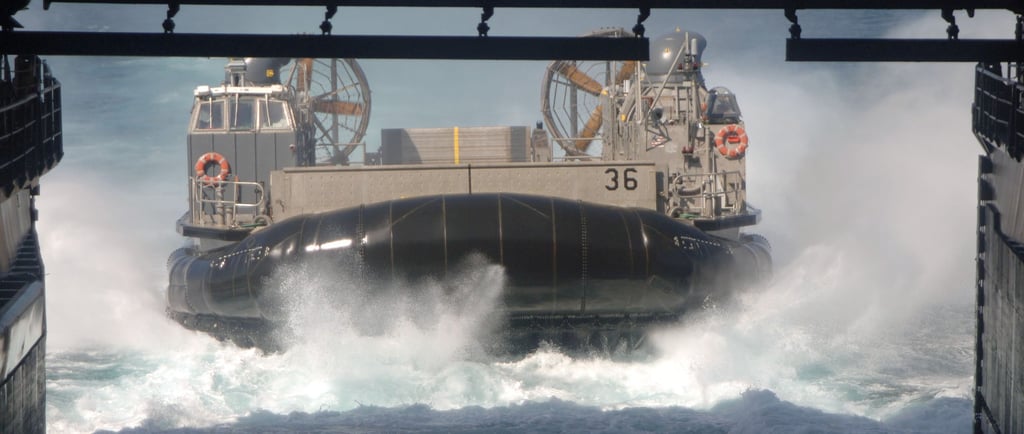LCACs: The High-Speed Workhorses of Amphibious Warfare
When it comes to moving troops, vehicles, and supplies from sea to shore, few platforms are as effective as the Landing Craft Air Cushion (LCAC). Designed for rapid deployment in amphibious operations, the LCAC is a game-changer for modern naval warfare, allowing the U.S. Navy and Marine Corps to launch assaults and humanitarian missions with unprecedented speed and flexibility.
Dr Edwards


What is an LCAC?
The Landing Craft Air Cushion (LCAC) is a high-speed, amphibious hovercraft used to transport personnel, vehicles, and equipment from ships to shore. Unlike traditional landing craft that plow through water and struggle with beach landings, the LCAC rides on a cushion of air, allowing it to traverse water, land, mud, and even ice.
First introduced in the 1980s, the LCAC was designed to solve a fundamental problem in amphibious warfare: the need for a fast, versatile craft capable of landing on virtually any shoreline. Today, the LCAC is a critical component of the U.S. Navy’s and Marine Corps’ Expeditionary Warfare strategy.
Speed and Mobility: The LCAC Advantage
One of the LCAC’s biggest strengths is speed. Unlike traditional landing craft, which have a top speed of around 8-12 knots (9-14 mph), the LCAC can reach speeds of 40+ knots (46+ mph), making it one of the fastest amphibious assault craft in the world.
The ability to hover above the surface rather than push through water allows the LCAC to avoid obstacles such as:
Shallow reefs
Sandbars
Mines and underwater obstructions
Ice and marshy terrain
This versatility ensures that Marines and their equipment can land on over 70% of the world’s coastlines, many of which would be inaccessible to traditional landing craft.
Payload and Firepower: Delivering the Fight
Despite its speed, the LCAC is a heavy-duty workhorse. It can carry:
Up to 75 tons of cargo – including M1 Abrams tanks, Humvees, artillery, and supplies.
Over 180 fully equipped Marines, ready to storm the beach.
Heavy equipment for humanitarian missions, such as medical supplies and disaster relief aid.
While not designed as a combat vehicle, the LCAC is armed with .50 caliber machine guns and can be equipped with countermeasure systems to defend against small arms fire and missile threats.
How the LCAC Supports Amphibious Warfare
The LCAC plays a vital role in amphibious assault operations, enabling Marines to land quickly and establish a beachhead before enemy forces can respond. In large-scale amphibious operations, LCACs are deployed from Amphibious Assault Ships (LHDs, LHAs, and LSDs), racing to shore to deliver troops and heavy equipment in rapid succession.
Some of the key missions LCACs support include:
Amphibious Assaults – Delivering Marines and armored vehicles for beach landings.
Humanitarian Assistance & Disaster Relief – Providing aid in disaster-stricken areas where traditional ships or aircraft cannot reach.
Special Operations – Deploying special forces units in hostile or denied areas.
The Future of LCACs: The SSC (Ship-to-Shore Connector)
While the LCAC has been an incredible asset for the U.S. Navy, newer threats and modernized warfare demand an upgrade. Enter the SSC (Ship-to-Shore Connector), the next-generation LCAC currently replacing older models.
The SSC features:
More powerful engines for greater speed and efficiency.
Increased durability for longer operational lifespans.
Advanced digital controls for improved maneuverability.
With the SSC, the U.S. Navy ensures that its amphibious forces remain unmatched in speed, agility, and global reach.
Conclusion
The LCAC is one of the most important tools in the U.S. Navy and Marine Corps arsenal, providing unmatched speed, versatility, and heavy-lift capability for amphibious operations. Whether storming enemy-held beaches or delivering aid to those in need, the LCAC ensures that the U.S. military can project power anywhere in the world—fast.
As newer technologies emerge, the Ship-to-Shore Connector (SSC) will take the LCAC’s legacy even further, ensuring that American forces remain at the forefront of modern amphibious warfare.